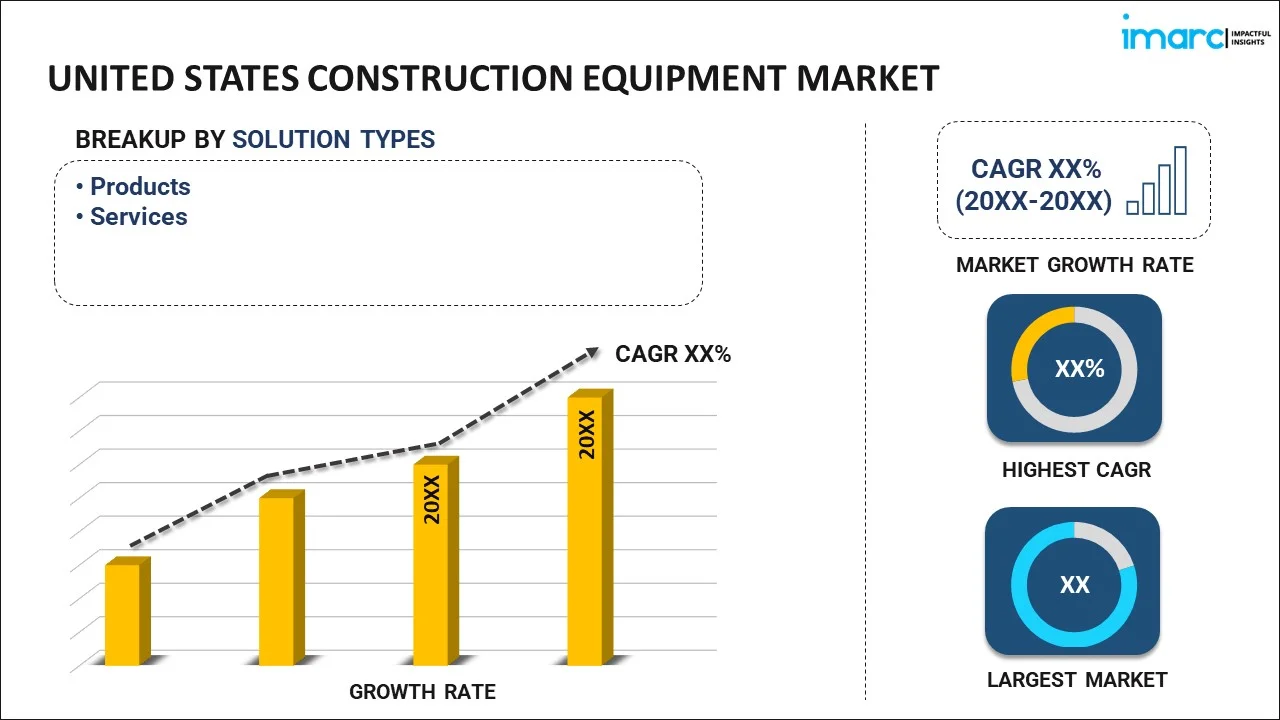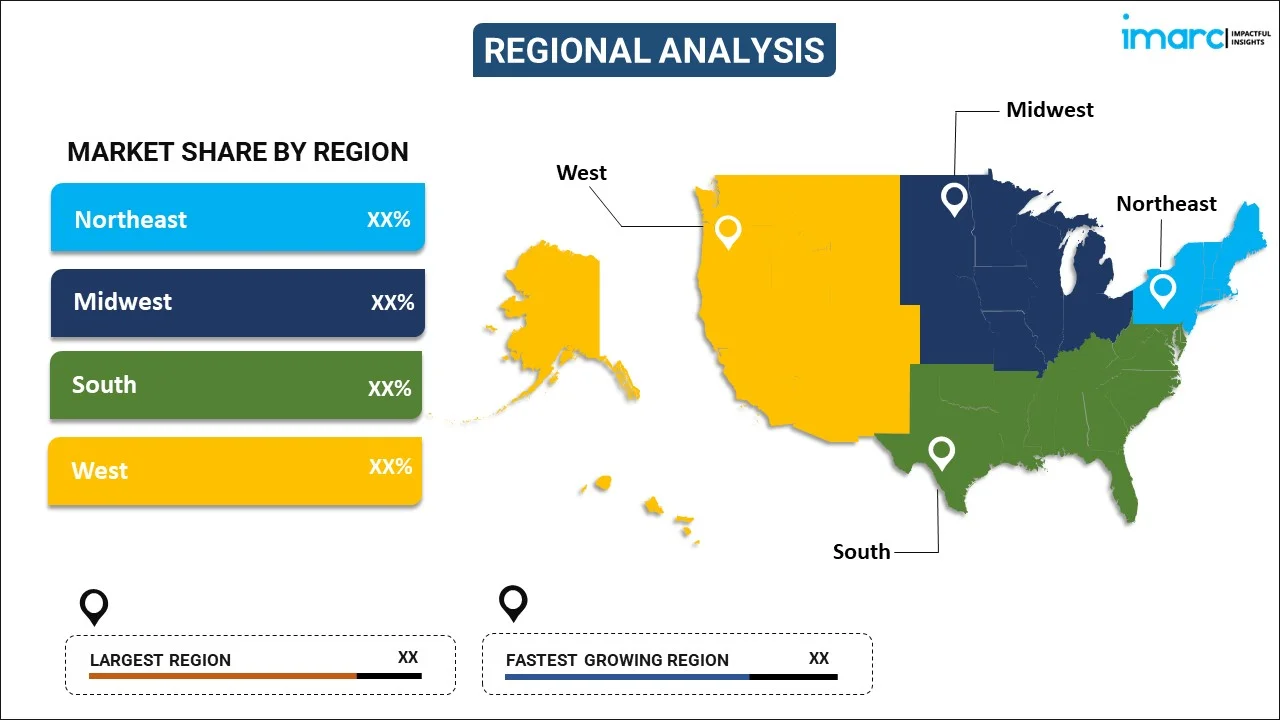
United States Construction Equipment Market Report by Solution Type (Products, Services), Equipment Type (Heavy Construction Equipment, Compact Construction Equipment), Type (Loader, Cranes, Forklift, Excavator, Dozers, and Others), Application (Excavation and Mining, Lifting and Material Handling, Earth Moving, Transportation, and Others), Industry (Oil and Gas, Construction and Infrastructure, Manufacturing, Mining, and Others), and Region 2025-2033
Market Overview:
The United States construction equipment market size is projected to exhibit a growth rate (CAGR) of 4.37% during 2025-2033. The increasing infrastructure development, including roads, bridges, airports, and public transportation, the construction of residential and commercial properties, and the integration of advanced technology into construction equipment represent some of the key factors driving the market.
|
Report Attribute
|
Key Statistics
|
|---|---|
|
Base Year
|
2024 |
|
Forecast Years
|
2025-2033 |
|
Historical Years
|
2019-2024
|
| Market Growth Rate (2025-2033) | 4.37% |
Construction equipment refers to a diverse range of machinery, tools, vehicles, and equipment used in construction projects for various purposes. These specialized tools are designed to perform specific tasks efficiently, contributing to the construction and development of infrastructure, buildings, and other structures. Construction equipment plays a pivotal role in enhancing productivity, reducing manual labor, and completing projects within stipulated timeframes. The types of construction equipment vary widely, encompassing earthmoving equipment, material handling equipment, construction vehicles, and various tools tailored for specific construction tasks. They are vital for the successful execution of construction projects, ensuring efficiency, accuracy, and safety. The selection of appropriate equipment depends on the nature and scale of the construction project. As technology advances, construction equipment continues to evolve, incorporating innovations such as GPS technology, telematics, and automation to enhance precision, safety, and overall project efficiency.
United States Construction Equipment Market Trends:
One of the primary drivers for the construction equipment market in the United States is significant infrastructure investment. Federal and state governments allocate substantial funds for infrastructure development, including roads, bridges, airports, and public transportation. This sustained investment drives the demand for construction equipment, such as excavators, bulldozers, and pavers, to execute these projects efficiently. In addition, the construction of residential and commercial properties remains a robust driver of the market. Population growth, urbanization, and economic expansion lead to increased demand for housing, office spaces, and retail centers. Construction equipment like cranes, loaders, and concrete mixers are essential for constructing these buildings. Besides, renovation and remodeling projects contribute significantly to the demand for construction equipment. Homeowners and businesses invest in upgrading existing structures, which often require equipment like power tools, excavators, and compactors to carry out renovations efficiently. Moreover, the integration of advanced technology into construction equipment is driving market growth. Features like GPS tracking, telematics, and automation enhance equipment efficiency, safety, and productivity. Contractors are increasingly adopting technologically advanced machinery to stay competitive and meet project deadlines. Additionally, environmental regulations and sustainability goals are influencing the choice of construction equipment. Electric and hybrid construction machinery is gaining popularity due to its reduced environmental impact and lower operating costs. Federal and state incentives for green construction practices also drive adoption. Furthermore, the rental market for construction equipment is expanding. Many contractors opt to rent equipment rather than purchasing it outright to reduce capital expenditures. This trend drives rental equipment companies to maintain updated fleets, contributing to the overall market.
United States Construction Equipment Market Segmentation:
IMARC Group provides an analysis of the key trends in each segment of the market, along with forecasts at the country level for 2025-2033. Our report has categorized the market based on solution type, equipment type, type, application, and industry.
Solution Type Insights:

- Products
- Services
The report has provided a detailed breakup and analysis of the market based on the solution type. This includes products and services.
Equipment Type Insights:
- Heavy Construction Equipment
- Compact Construction Equipment
A detailed breakup and analysis of the market based on the equipment type have also been provided in the report. This includes heavy construction equipment and compact construction equipment.
Type Insights:
- Loader
- Cranes
- Forklift
- Excavator
- Dozers
- Others
The report has provided a detailed breakup and analysis of the market based on the type. This includes loader, cranes, forklift, excavator, dozers, and others.
Application Insights:
- Excavation and Mining
- Lifting and Material Handling
- Earth Moving
- Transportation
- Others
A detailed breakup and analysis of the market based on the application have also been provided in the report. This includes excavation and mining, lifting and material handling, earth moving, transportation, and others.
Industry Insights:
- Oil and Gas
- Construction and Infrastructure
- Manufacturing
- Mining
- Others
The report has provided a detailed breakup and analysis of the market based on the industry. This includes oil and gas, construction and infrastructure, manufacturing, mining, and others.
Regional Insights:

- Northeast
- Midwest
- South
- West
The report has also provided a comprehensive analysis of all the major regional markets, which include Northeast, Midwest, South, and West.
Competitive Landscape:
The market research report has also provided a comprehensive analysis of the competitive landscape. Competitive analysis such as market structure, key player positioning, top winning strategies, competitive dashboard, and company evaluation quadrant has been covered in the report. Also, detailed profiles of all major companies have been provided.
United States Construction Equipment Market Report Coverage:
| Report Features | Details |
|---|---|
| Base Year of the Analysis | 2024 |
| Historical Period | 2019-2024 |
| Forecast Period | 2025-2033 |
| Units | Billion USD |
| Scope of the Report | Exploration of Historical and Forecast Trends, Industry Catalysts and Challenges, Segment-Wise Historical and Predictive Market Assessment:
|
| Solution Types Covered | Products, Services |
| Equipment Types Covered | Heavy Construction Equipment, Compact Construction Equipment |
| Types Covered | Loader, Cranes, Forklift, Excavator, Dozers, Others |
| Applications Covered | Excavation and Mining, Lifting and Material Handling, Earth Moving, Transportation, Others |
| Industries Covered | Oil and Gas, Construction and Infrastructure, Manufacturing, Mining, Others |
| Regions Covered | Northeast, Midwest, South, West |
| Customization Scope | 10% Free Customization |
| Post-Sale Analyst Support | 10-12 Weeks |
| Delivery Format | PDF and Excel through Email (We can also provide the editable version of the report in PPT/Word format on special request) |
Key Questions Answered in This Report:
- How has the United States construction equipment market performed so far and how will it perform in the coming years?
- What has been the impact of COVID-19 on the United States construction equipment market?
- What is the breakup of the United States construction equipment market on the basis of solution type?
- What is the breakup of the United States construction equipment market on the basis of equipment type?
- What is the breakup of the United States construction equipment market on the basis of type?
- What is the breakup of the United States construction equipment market on the basis of application?
- What is the breakup of the United States construction equipment market on the basis of industries?
- What are the various stages in the value chain of the United States construction equipment market?
- What are the key driving factors and challenges in the United States construction equipment?
- What is the structure of the United States construction equipment market and who are the key players?
- What is the degree of competition in the United States construction equipment market?
Key Benefits for Stakeholders:
- IMARC’s industry report offers a comprehensive quantitative analysis of various market segments, historical and current market trends, market forecasts, and dynamics of the United States construction equipment market from 2019-2033.
- The research report provides the latest information on the market drivers, challenges, and opportunities in the United States construction equipment market.
- Porter's five forces analysis assist stakeholders in assessing the impact of new entrants, competitive rivalry, supplier power, buyer power, and the threat of substitution. It helps stakeholders to analyze the level of competition within the United States construction equipment industry and its attractiveness.
- Competitive landscape allows stakeholders to understand their competitive environment and provides an insight into the current positions of key players in the market.
Need more help?
- Speak to our experienced analysts for insights on the current market scenarios.
- Include additional segments and countries to customize the report as per your requirement.
- Gain an unparalleled competitive advantage in your domain by understanding how to utilize the report and positively impacting your operations and revenue.
- For further assistance, please connect with our analysts.
 Inquire Before Buying
Inquire Before Buying
 Speak to an Analyst
Speak to an Analyst
 Request Brochure
Request Brochure
 Request Customization
Request Customization




.webp)




.webp)












